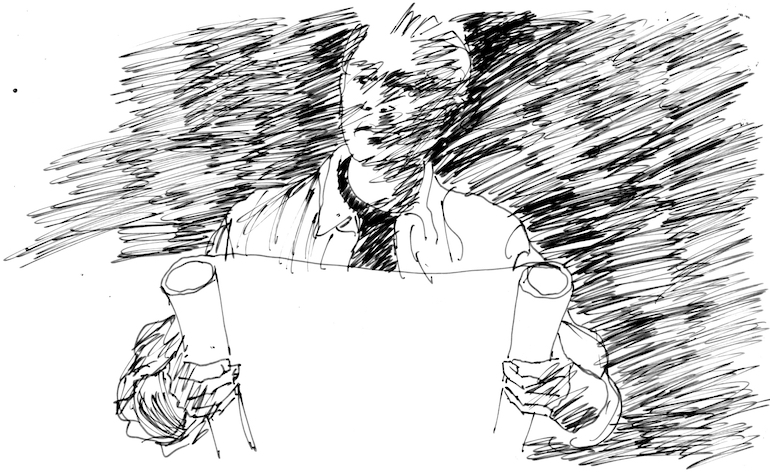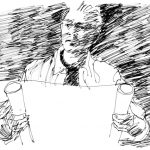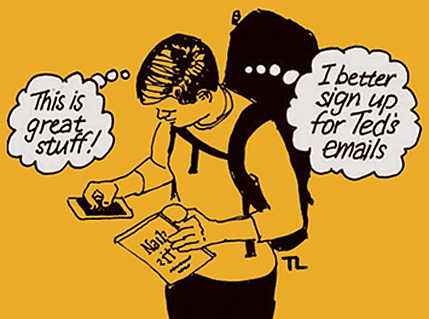Attention deficit

It was my first opportunity to win a truly global client. One headquartered outside Seattle. A very big deal for our small firm.
In my initial conversation with the client, he described their needs and we set a date to meet. During the call, I learned that they had been going through a period of significant change. They were particularly concerned that shareholders and their own sales force understand the transformation and how it was preparing the company for the future.
I had a couple of weeks to prepare. And as usual for me I found my attention taken by everything but the need to focus on this amazing opportunity.
Part of my lack of focus was my fear of the competition. During my call, I’d also learned that my competitors were two major players. Both of which held global reputations. Both with considerably more status than we had.
I now know that procrastination, when the odds seem against me, is a bit of a pattern. One I’ve struggled with my whole life. And one that has derailed me more than once. (My chicken ranch story holds another take on this pattern.)
Despite my procrastination, I did manage to gather several current business articles about the company including the text of a talk the founder had given to an industry group.
And by pure chance, I ran into a local branch manager socially. I told him what I was preparing for and asked if he’d be willing to be interviewed. He did, and I recorded it with his permission.
Action
The weekend before my flight, my fear of the competition was pushed aside by my fear of looking bad. With Monday fast approaching I settled down to read the articles and other material I’d collected, and I listened to the interview I’d taped. I spent most of Saturday reading and making notes, not sure how I’d use them.
On Sunday I awoke knowing what to do. During the night, I’d pictured myself rolling out a long scroll with the objective on one end and the approach at the other. In between were all the notes of significant and not so significant events described in my discovery effort that led to my insight on the messaging approach.
It’s a challenge
Knowing where to put my efforts and how to keep my focus is tricky. It’s always been a challenge for me.
It’s tricky because I’ve always had difficulty staying on track. I’m easily drawn into distractions. Something captures my attention and down the rabbit hole I go following whatever it is that tugged me away from what it is, that I need to do, to stay on track.
When I need to prepare for something more, rather than less critical, I’m all the more distractable.
I now know that I have a classic case of Attention Deficit Hyperactive Disorder, (ADHD).
I hate the inclusion of the word “disorder” in that description. Why? Because my attention may wander but I am extremely capable and proudly independent. I think of my rapidly changing focus as an asset. Part of my fast-twitch personality. But I have to admit that my attention will wander when I need to focus.
However, once I do get into the groove on the critical subject I become completely focused. The trick is in finding my way into that groove. Finding my way to the hyper-focus part of my ADHD.
I’ve found that my success in managing my ADHD is the result of a series of workarounds that somehow, I discovered and learned to use over the course of my life.
My workarounds
Understand the need
I try to be able to describe what it is that my client needs to accomplish in the least number of words possible. Succinct, tight descriptions help me absorb the need.
Gather information
When I can do nothing else. When I’m unable to focus I’ve found that the best thing I can do is gather stuff to study when I can focus.
Talk about it
Have a discussion with someone who is also engaged in the subject. Listen carefully and take notes on what they say. By the way, listening is a key ingredient in critical understanding, and it helps anyone not just those of us with ADHD.
Read about it
Like listening, reading is another proven way to focus your mind. And knowing what others say provides confidence and can give me a sense of mastery when I have found my way into the groove.
Visualize
When I awoke that Sunday morning with the scroll in my head the visualization was the natural result of the work, I’d done before drifting off Saturday night. Working the problem all day is a great way to set myself up for the magic that can happen during sleep.
Find adventure
That visual of myself as a hero rolling out that scroll for my admiring client added a sense of adventure to the work. That sense of adventure enabled my ability to hyper-focus. And gave me the energy to complete my scroll.
Go for a run
When I’m stuck. Don’t know what to do. Feeling desperate or afraid there is nothing like a run to get me started again and feeling good about myself and the opportunity at hand.
I now know that what I’ve always thought of as “workarounds” are the warmups that lead to creative action. The anxiety. The not knowing what to do. The discomfort. These are all part of the creative process. And are certainly not unique to me.
What happened
My flight was the first one out that morning. I think it was still dark. Once aboard it was gallons of coffee that brought back the high, I needed. Then the taxi into town. Passing muster with corporate security. Elevator to the top. Personal assistant, all professional, reserved and well over six feet tall. Down the hall past the corporate art collection. Wait, was that a Picasso? Yes, it was. The waiting room. Panoramic view of the city More coffee. Getting a bit jittery now.
“Mr. Leonhardt you can go in now.”
It worked. He loved it so much he asked me to wait while he rolled it up and took it in to show his boss.
We got the work.



4 Comments
ADHD is not an urban myth. Full discloser, I am happily married to Ted Leonhardt.
I am responding to Ted’s article where he bravely came out as a person living with ADHD. I began a serious study of ADHD about 15 years ago as a psychotherapist and psychoanalyst. I am continually shocked to find that many in my field and the generalized population are oblivious to what ADHD is — thus perpetuating all kinds of unfounded myths — the most egregious being that ADHD does not exist at all.
Generally speaking the main symptom is an inability to sustain one’s attention on a single task, any task including relational interactions (search mayoclinic symptoms of ADHD). One of Ted’s important points is that he can hyper-focus once he gets started and believe me I have seen him plow through a single project throughout the day into the night — day after day. While this may be a super-power, the downside is getting started or starting on a project one might feel anxiety about, like the woman who could not file her taxes for 10 years (anxiety, ADHD) and man who could not clean up his clutter (ADHD, depression, anxiety). While Ted has work-arounds, including hiring people to do tasks he has difficulty attending to (or loathes), an adult higher on the ADHD spectrum may need professional help.
ADHD is a developmental neurological disorder meaning that most who are diagnosed are born with neuro-diversities that fall into certain descriptive categories — Hyperactive and In-attentive — the “dreamy type” or both. Hyperactives tend to perform better in sports activities and the in-attentives may have talent but can be seen on the baseball field, for example looking at the birds while missing a catch. ADHD does not affect one’s general intelligence (IQ) and is considered a performance disorder involving impulsivity and self-control (search Barclay on ADHD). A part of the brain we use to organize and think about our lives (executive functioning) is less operative and this can be measured in various tests (search psychologytoday on executive functioning).
Ted was diagnosed late in life and I would guess he is on the low end of the ADHD spectrum because he has managed a number of work-arounds to compensate for executive functioning deficits on his own — without treatment. Treatment for kids and adults today has a three-prong approach following a solid diagnosis. This includes medication, psycho-education and therapy. A psychiatrist will work with the patient to determine what or if medication is warranted, but I have seen lives turn towards much higher functioning over night with a regulated medication regimen. Psycho-education treatment focuses on cognitive behavioral therapy (emotional regulation), mindfulness practices (stress regulation) and organizational strategy building. These are tools support everyday living and include stress/anxiety management, rumination management, time regulation, memory tools and so on. Psychotherapy supports the psychological development of a person who may have feelings of inferiority or “imposter syndrome” due to an inconsistency of performance overtime possibly contributing to a build-up of anxiety, depression and low self-esteem. Undiagnosed kids, for example are vulnerable to drug and alcohol addiction that may carry into adulthood if not interceded.
My bias is that all children with an ADHD diagnosis today will be greatly supported with the various treatments available and spared some of the entrenched suffering older adults today had to endure without support.
Lastly, I want to emphasize that while ADHD may seem more prevalent in creative occupations, you may be surprised to know that I have known this diagnosis to be a cross-occupational phenomena effecting the functioning of physicians, dentists, engineers, lawyers and accountants to name a few. Ted and I have joked about how better suited ADHDers would be living in a hunter-gather society where tribal life offered unlimited stimulation and variety of tasks using one’s bodies fully with and amongst others towards a common goal — surviving and well-being. To my mind, whether you have ADHD or not, those who know what their gifts and limitations are will be better able to creatively craft a life in today’s world such it is. Creatives in particular will need to find strength in communities that support our emotional/social intelligence and creative buoyancy when meeting the rapidly changing occupational perimeters of our global hyper-technological age.
Thanks Robin! I know readers will appreciate your professional insights and additions on ADHD.
Brilliant. I relate to so much of this story, but in particular I appreciate your identification that anxiety is part of the process. I have been working to accept anxiety as a teacher: “what is this about? What invitation is here?” And I also appreciate what your partner pointed out, around the spectrum of neurodiversity and conditions that folks live with. Thanks for publishing this.
Thanks Dave, good way of putting it, “anxiety as a teacher”. As my Robin likes to remind me, “we’re all little animals”. Our emotions show us a lot about what’s really important!